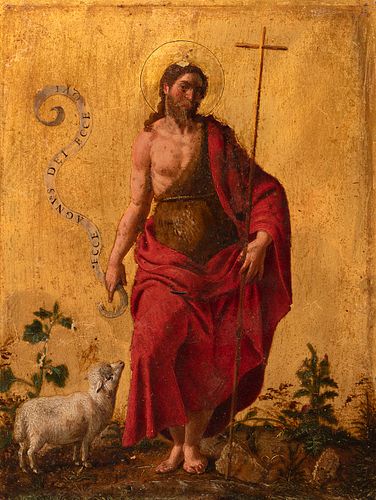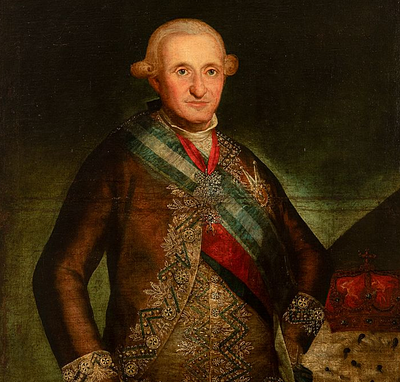Italian school; ca. 1600. "San Juan Bautista". Oil on gilded bronze.
Lot 12
About Seller
Setdart Auction House
Carrer Aragó 346
Barcelona
Spain
Setdart Subastas was born in 2004 and is currently the first online art auction in Spain with solidity, prestige and reliability guaranteed by our more than 60,000 users. Setdart has a young, dynamic and enterprising team ready to successfully manage the purchase and sale of art works through custom...Read more
Estimate:
EUR€4,000 - EUR€6,000
$4,123.71 - $6,185.57
Absentee vs Live bid
Two ways to bid:
- Leave a max absentee bid and the platform will bid on your behalf up to your maximum bid during the live auction.
- Bid live during the auction and your bids will be submitted real-time to the auctioneer.
Bid Increments
| Price | Bid Increment |
|---|---|
| EUR€0 | EUR€10 |
| EUR€200 | EUR€25 |
| EUR€500 | EUR€50 |
| EUR€1,000 | EUR€100 |
| EUR€3,000 | EUR€200 |
| EUR€5,000 | EUR€500 |
| EUR€10,000 | EUR€1,000 |
| EUR€20,000 | EUR€2,000 |
| EUR€50,000 | EUR€5,000 |
About Auction
By Setdart Auction House
Sep 22, 2021
Set Reminder
2021-09-22 09:30:00
2021-09-22 09:30:00
America/New_York
Bidsquare
Bidsquare : 22nd September - ARAS JÁUREGUI Private Collection - Old Masters, 19th & 20th Century
https://www.bidsquare.com/auctions/setdart-auction-house/22nd-september---aras-j-uregui-private-collection---old-masters-19th-20th-century-7427
ARAS JÁUREGUI Private Collection - Old Masters, 19th & 20th Century Setdart Auction House sofia@setdart.com
ARAS JÁUREGUI Private Collection - Old Masters, 19th & 20th Century Setdart Auction House sofia@setdart.com
- Lot Description
Italian school; ca. 1600. "San Juan Bautista". Oil on gilded bronze. Measurements: 16 x 12 cm. Scene of devotional character that, due to the support used and the small dimensions of the format, it is probable that it was conceived for personal devotion, being thus object of private collection. The image shows the figure of Saint John the Baptist, which can be deduced from the iconographic attributes that accompany him, such as the lamb, the skin that covers his body, the red cloak, the cross of reeds and the phylactery that reads "ECCE AGNUS DEI ECCE QVI", in relation to the phrase "Ecce Agnus Dei, ecce qui tollit peccatum mundi (Behold the Lamb of God, behold the one who takes away the sin of the world). The figure of the saint is inscribed in a low horizon, giving greater importance to the sky, made up of gilded bronze. A colour that indicates the immeasurability of the Christian religion, related to values such as eternity and universality. The Gospels say of John the Baptist that he was the son of the priest Zechariah and Elizabeth, cousin of the Virgin Mary. He withdrew at a very young age to the desert of Judea to lead an ascetic life and preach penance, and recognised in Jesus, who was baptised by him, the Messiah announced by the prophets. A year after Christ's baptism, in the year 29, John was arrested and imprisoned by the tetrarch of Galilee Herod Antipas, whose marriage to Herodias, his niece and sister-in-law, he had dared to censure. Finally St. John was beheaded, and his head given to Salome as a reward for his beautiful dances. This saint appears in Christian art in two different guises: as a child, a playmate of Jesus, and as an adult, an ascetic preacher. The adult Saint John depicted here is dressed in Eastern art in a camel-skin sackcloth, which in the West was replaced by a sheepskin, leaving his arms, legs and part of his torso bare. The red cloak he wears at times, as well as in the scene of his intercession at the Last Judgement, alludes to his martyrdom. In Byzantine art he is depicted as a large-winged angel, with his severed head on a tray which he holds in his hands. However, his attributes in Western art are very different. The most frequent is a lamb, which alludes to Jesus Christ, and he often carries a cross of reeds with a phylactery with the inscription "Ecce Agnus Dei".
- Shipping Info
-
In-house shipping available. Please inquire at admin@setdart.com.
-
- Buyer's Premium



 EUR
EUR CAD
CAD AUD
AUD GBP
GBP MXN
MXN HKD
HKD CNY
CNY MYR
MYR SEK
SEK SGD
SGD CHF
CHF THB
THB

















